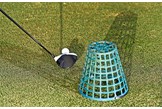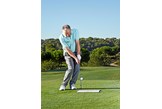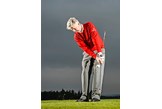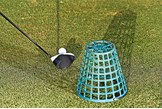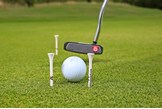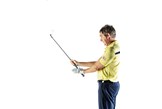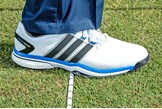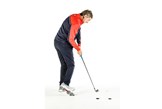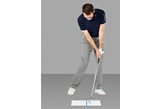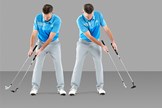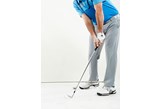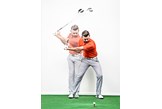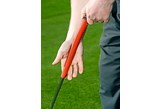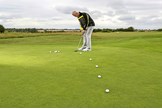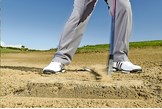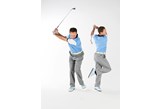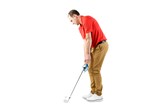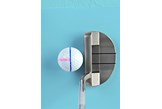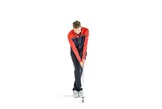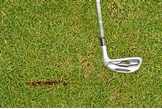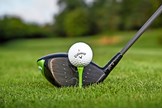50 fast fixes for your golf game
Published:
Get better in a hurry with our hand-picked selection of simple and effective tips and drills… for your swing, your brain and your golf bag
It’s generally accepted that in golf, to make genuine strides forward with your
game you have to invest a huge amount of time, effort and expense. Nonsense. Any coach will tell you that five minutes working on the right things is better than five hours of directionless range work.
The trick lies in sifting through the bajillion morsels of ‘wisdom’ available to us all these days to uncover the truly effective fast fixes… and that’s exactly what we’ve done for you here.
Targeting your swing, your gear and your mental approach, each one of these 50 golden nuggets represents a proven and expert- selected segue to speedy and lasting improvement.
So, in the spirit of the moment, let’s get straight to them.
• Equipment
• Set Up & Swing
• Driving & the Long Game
• Iron Play
• Short Game
• Bunkers
• Putting
• Mental Game
Equipment
Replace your 10-year-old driver
Research suggests golfers update their driver every five years or so. If your driver is much older than that, you’ll likely see substantial gains in ball speed, dispersion and carry by switching to a new one. Our old v new driver test last year saw a 2mph ball speed and 12-yard distance gain comparing a five-year-old TaylorMade SLDR against the latest model, which would mean hitting at least one less club into greens. The difference will be even greater as the driver gets older. Make sure you get custom fitted, too.
Try a cavityback wedge
Cleveland are the major players when it comes to cavity-back wedges, and their arguments for more golfers using them are strong. They say most wedges have been designed with a topdown approach, which means tour players get wedges to suit their games, but club golfers miss out on attributes which suit theirs. In our tests, Cleveland’s CBX 2 wedge was three or four yards more accurate than a tourstyle model; that’s nine-12 feet, which could mean the difference between holding an approach on the edge of a green or tumbling off and making bogey or worse.

Regrip your clubs
When was the last time you changed your grips? Worn or slick grips, or ones that are too big/ small for your hands, can have a major impact on your scores. General usage, oils on your hands, UV light, dirt and other natural elements will wear down rubber grips, just like a car’s tyres. Over time, grips lose their tackiness and traction and the more you play, the more you should replace your grips. Holding a slick grip tighter cuts club speed and costs distance. Worn grips may also slip, causing a loss of accuracy. If a grip’s too big for you, there’s an adage that your hands will struggle to square the clubface at impact. Whereas if the grips are too small, there’s a danger that your hands will be too active and initiate an early release.
Get a putter that’s the right length
Ping say that eight out of 10 golfers are using the wrong length putter. Ping’s tour players use putters between 32 and 36 inches, yet putters are traditionally sold in either 34in or 35in lengths, so it’s not surprising so many of us get it wrong. The wrong length putter makes it difficult to putt consistently, as putts will often be hit off centre which leads to not only distance control issues but accuracy problems, too. Factor in how you use the putter more often than any other club and you can see why it’s so important to get it right.

More distance? Try lower-lofted irons
Cranking lofts (where brands essentially turn a 7-iron into a 6-iron) to add ball speed and distance hasn’t had the best of reputations over the years, as shots typically fly lower with less spin, which makes it difficult to stop them on a green. But some of the latest strong-lofted iron models are better at flighting shots higher with more spin than ever before. Some of the change comes down to new technology and how heads react at impact; lighter, higher-launching shafts play a part, too. Strong lofts aren’t for everyone; if you struggle to flight shots high from the turf they’re probably not worth considering. But for golfers who seriously want to add distance to their iron game and don’t have an issue launching shots high, they can be a revelation.
Swap your long irons for hybrids
There’s no point having clubs in your bag which fill you with fear. Lots of golfers struggle to get a perfect long game set-up, bridging the gap between a driver and irons. But unless you have any hard and fast likes or dislikes, we’d see it like this. If you swing at a moderate speed (driver swing at 85mph or less) and sweep shots away rather than hitting down and engaging the turf, it’s likely you’ll find wider body, higher lofted fairway woods the most forgiving and easiest to launch from turf. When your swing rises to 95mph (driver) you’re more likely to find wider body hybrids plug gaps between a fairway wood and irons best. Should you be lucky enough to swing at 105mph, it’s time to look at narrow hybrids and utility irons.
Try a draw-biased driver
Modern draw drivers are a revelation! They’re branded up in exactly the same way as any normal driver, meaning you don’t look like a hacker before you’ve even teed up. Gone are the days of mega closed faces which look dreadful at address and in their place are cleverly disguised draw models which have enough mass located in the heel to help you stay away from the right side of the golf course (right handers). Ping’s G410 SFT and TaylorMade’s M6 D-Type are among our favourites, and if you’ve got a moderate swing speed there’s even a draw model aimed at you, the offset Cobra F-Max Superlite.

Try a counterbalanced putter
If you’re at the end of your tether with a wonky putting stroke why not give a counter-balanced putter a try? Extra weight in the grip end (which is above the hands) improves overall MOI stability, which helps iron out kinks in a putting stroke. The real beauty nowadays is that you don’t need to invest in a whole new putter to get the counter-balanced effect.
The clever engineers at SuperStroke have built CounterCore into each of the brand’s new Traxion putter grips. It means you get a new putter grip, but can also fiddle with 25g, 50g and 75g weights in the top of the grip to give the effect or feel you’re after.
Choose the best ball for you
Our recent robot test revealed a 10-yard difference (driver) between the longest and shortest balls on sale. Our advice is set yourself a budget, then look at the options at that price point. These are our four favourites.
Tour level: If you’re happy to pay for a tour ball our numbers say TaylorMade’s TP5x (the only ball we tested to average 300 yards carry with the driver) is a great option as it’s accurate and gives up little spin v the highest spinning wedge ball
Club golfer: Callaway’s ERC Soft is especially low spin with the driver, which makes it long, without giving up huge amounts of spin on iron and wedge play. You also get Triple Track alignment lines, to help you set up square
Mail order: Mail order golf balls have sprung up because there’s lots of profit margin in tour level balls. Our results show how Snell’s MTB-X is very closely matched to the Titleist Pro V1x, yet they’ll cost you £22 a dozen less.
Under £25 a dozen: Lots of club golfers could do much worse than investing in a few dozen Srixon AD333. They give up virtually nothing against a Pro V1 and, thanks to the lower cost, you’ll be able to afford to play the same ball all year.

Set-Up & Swing
Improve your balance
Darren Parris, North Foreland GC
Place an alignment stick or old shaft parallel to your ball-to- target line and stand on it, making sure it runs under the centre of both feet. Address a ball with a mid/short iron and check your balance at set-up; the stick will tell you if you’re too much in the toes or heels.
From here hit 10 balls, again focusing on your balance; the stick reveals any toe/heel tendencies and really highlights where your balance should be. Finally, hit 10 normal shots without the stick to feel the improvement in your balance.

Grip: Find a more effective gloved-hand hold position
Lee Scarbrow, John O’Gaunt GC
Most golfers take hold of the club with the head sitting on the ground. With the handle relatively upright, it’s hard to route the club through the correct part of the hand. The palm tends to be introduced more under the handle. Instead, take your grip with the shaft angled upward at around 45°. With the club in this position, it’s much easier for you to push the correct part of the lead palm against the grip. From here, follow the golden rule of “palm first, fingers second”. Check the grip runs from the palm crease under the heel of the hand to the index finger knuckle. This will help you get the feeling of
the palm being more on top of the grip than under it.

Build a strong, inside attack
Lee Scarbrow, John O’Gaunt GC
Find two small objects, broken bits of tee or stones. Position the first 12-18in behind the ball on an extension of your ball-target line. Put the second one 6in inside it. Take your 6-iron and simply work on swinging the club back over the outer stone, and down over the inner one. This reverses the inside-and-over- the-top loop trap so many slicers fall into, and helps you hone a more effective inside attack.

Train a compact, powerful backswing
Adrian Fryer, Liverpool Golf Centre
Often, when we go searching for power we make an overlong backswing, which compromises balance and strike. To beat this, form an extra-wide stance, the feet spread twice as much as normal. Keep the ball position under your lead shoulder. This wide stance effectively locks your hips, limiting their ability to turn. From here, try to turn your lead shoulder under your chin. With hip rotation restricted, this will give you the feeling of coiling your upper body against the hips’ resistance – a powerful position that creates torque and promotes the correct, lower body-led downswing sequence.

Driving & the Long Game
Add power to your turn
Lee Cox, The Shire, London
The age-old “shoulder-turn” drill – club pinned to shoulders – creates some basic mobility through the core, but it fails to engage the shoulders with any dynamism. To feel the difference, take your address without a club and form fists with both hands. Now punch powerfully behind you with your gloved hand. As you do so, allow your trail elbow to push forwards, towards the target. This move helps you feel how your two shoulders can work separately to increase turn. Make this move and turning past 90º becomes much easier.

Tee it high, let it fly
Gareth Johnston, Calcot Park
A high tee promotes impact on the upper portion of your driver’s clubface. This region of the face is typically more lofted due to vertical face curve ‘roll’, and imparts a lower spin rate as it is above the club’s centre of gravity. This means you increase your chances of the high-launch, low spin combination that has been proven to help your drives go further, without any increase to clubhead speed.

Check and change an out- to- in attack
Gareth Johnston, Calcot Park
On your next visit to the range, take the ball basket and position it upside down on the ground, opposite the toe of the driver at address. Leave just a small gap between the toe and the basket. Now hit a series of drives. If your attack path is out-to-in, the toe of your driver will catch the basket before the ball. To improve your path, leave the basket in the same place and set yourself a goal of making a swing that misses it. Often, a simple goal-led drill like this can be more effective than complex technical work.

Train a power sequence
Chris Ryan, HIT Golf Academy, Forest of Arden
Step 1. Start with feet together.
Address the ball normally – then pull your lead foot back against your trail foot so the ankles touch. Make a three-quarter backswing from this position.
Step 2. Plant the lead foot.
Start your downswing by replanting your lead foot back to its original address position. Make the move purposeful and aggressive, almost a stamp. Your lower body needs to lead your upper half into impact, and by getting some early momentum into your legs, knees and hips, this drill helps you feel and train that ideal power sequence.

Point the way to better plane
Gareth Johnston, Calcot Park
Draw a bold arrow on a pad and hold it at arm’s length opposite your chest, the arrow pointing vertically upwards and facing you. Keeping the pad in front of you, take your regular posture. Swing the pad back as if it was your club, keeping your focus on the arrow. Check its length is around the same angle as your shoulders, pointing up through your right
shoulder. This lets you rehearse an effective angle on which to swing the club.

Iron Play
Sharpen your ball striking
Ian Clark World of Golf
Here is one of the simplest and most effective ball-striking drills I’ve come across. Draw or picture a bold line on the grass at right angles to your ball-target line. Set up to it with a 7-iron, its leading edge against the line. Check the line represents a good ball position for your club, just forward of centre in your stance. From here, all you have to do is focus on striking the ground on the hole side of the line. With this as your simple intention, you will instinctively create many of the key ingredients of a clean, powerful striking position – including a better weight shift, later release of the club and powerful forward shaft lean.

Find your ideal swing plane
Adrian Fryer, Liverpool Golf Centre
Place two clubs on the ground, pointing to your target. Now take your 7-iron. Address the ball normally, but grip the 7-iron halfway along its shaft, below the grip. Swing halfway back, allowing the wrists to cock, until your lead arm is parallel with the ground. From here you can see the handle, and where it’s pointing. If your action is on plane, the butt of the club will point towards the shafts on the ground. If yours does not, move the club into position to improve your awareness of what on-plane feels like.

Hit the sweetspot more often
Jon Wallett, Elite Coaching Golf Academy
Turn the clubface through 90º, so the length of the blade is looking down the target line. Make your regular swing, ensuring the club makes contact with the ground. The orientation of the face leaves a narrow skid mark in the ground. Keep going until you can hit your original mark three times in a row; this sharpens your ability to swing the club through the same space every time. Finally, turn the club around and swing normally.

Train a more powerful strike
Jon Wallett, Elite Coaching Golf Academy
In the ideal delivery position, your trail wrist and right arm should feel ‘loaded’ or ‘cocked’ pre-impact. From this loaded position, you just release the right wrist and arm in a ‘karate chop’ motion. Centrifugal force created through the rotation of your body will automatically square the face; you should not consciously try to roll or rotate your arms. To feel this move, start by allowing your lower body to shift towards the target. Now make sure your trail arm and wrist are loaded, the palm facing in front of you. From here, deliver the blow with a karate chop of the right arm. Allow the momentum to take you through to a full follow-through. This drill will help you train a more powerful and better-timed strike.

Use a bag towel to promote stronger strikes
Steve Astle, Morley Hayes
Fold your bag towel into thirds and lie it across your target line, behind the ball as shown. Address the ball so your trail foot is opposite the middle of the towel. This places the ball three or four inches ahead of the towel for a mid/short iron. All you have to do with this drill is miss the towel coming into impact. Missing the towel means powerful lag retention and a squeezing attack angle. Contact with the towel provides painless yet pronounced proof of any casting or flicking at the ball.

Short Game
Strike cleaner chips and pitches
Alan White, Lanark Golf Club
Stick an alignment cane into the butt of your wedge. Address the ball normally, making sure there is a slight gap between your lead side and the cane. Hit chip shots with the stick in place. Your simple goal is to make sure you never let the cane touch your side during the shot. This proves your body is contributing to the strike through rotation. If your body stops and the hands flick, you’ll feel the cane against your side.
Add stability to your chip shots
Lee Scarbrow, John O’Gaunt GC
A common chipping error is trying to help the ball up, into the air. It creates a saggykneed look to the action, as the player drops down to get below the ball. To beat this, take this cross-legged stance, your trail leg wrapped over the front of your lead leg. As well as narrowing your stance – which demands more stability – you have locked your knees together. With this stance you can’t collapse or sag. Hit a series of chips. At first you’ll feed wooden, but persevere and you’ll begin to feel how this more stable base allows you to train a more consistent, level strike pattern.

Shift and rotate… without losing focus
Scott Cranfield, Cranfield Golf Academy
Step 1: Many golfers associate head movement with a loss of focus on the golf ball. Here is a great drill to help. Take your 7-iron, and adopt your regular stance. But as you swing back, pull your lead foot from the ground. Allow some minimal lateral movement to help yourself balance over your right or trail foot. Keep your eyes fixed on the ball.
Step 2: Now go ahead and swing through, still on your trail foot. Ok, this will test your powers of balance; but without your lead leg to support you, you will gain a keener understanding of the body’s ability to shift laterally and rotate without losing balance. Hit five balls like this and you’ll begin to see how movement doesn’t have to come at the expense of your focus on the ball.

Soften your hands for more short game feel
Kristian Baker, www.krist ianbaker.com
Take your bag towel off your bag. Fold it in half, then wrap it around the handle of your wedge. Take your regular grip, but over the towel. You will instantly feel how the extra thickness and softness encourage a more relaxed hold of the handle. Hit a series of chips and pitches with the towel in place. Don’t worry too much about where the balls go; instead, focus on the relationship between grip pressure and clubface awareness; note how, with those softer hands, the wrists hinge and unhinge more readily and the movement flows better.

Create a brushing arc on your chip shots
Adrian Fryer, Liverpool Golf Centre
Many golfers get too steep on short-game pitches and chips, an attack angle that causes heavy contact through the leading edge digging into the ground. To get on top of this, lie a bag towel a foot or so in front of the ball. Hit pitches with the towel in place. When you make the correct, more level attack, the clubhead will miss the towel on the way through: when you get steeper, the strike moves higher in the face and the clubhead will catch the towel.

Find a stronger pitch flight with your wedges
Darren Parris, North Foreland GC
The next time you practise wedge play, use your golf bag to wedge or prop up a horizontal cane or clubshaft a couple of feet in front of the ball, and a couple of feet above the ground. Simply hit shots, trying to squeeze the ball under the cane. This will create the forward shaft lean that de-lofts the face and gives your shots a lower, stronger flight.
Hold sand on the face to maintain loft
Gareth Johnston, Calcot Park
Play bunker shots with an open face and you promote loft and sole bounce – the rounded rear sole that stops the club digging. To train this open face, dig your sand wedge into the bunker to pile some sand on the face. Put your ball on top of the sand – you’ll need to open the face wide to achieve this. Now make a slow-motion swing, back and through; just try to keep the ball and sand on the face. To do that the face must point to the sky throughout… keeping the face open and the loft and bounce in their most effective position.
Shallow your sand wedge attack
Adrian Fryer, Liverpool Golf Centre
Rake sand into the form of a brick in front of you. Make sure the rectangle aims down your target line, and is around the height of two golf balls. Take your stance in front of the brick. Now make your regular swing, but as you swing through your goal is to remove the top layer of sand from the brick and no more. Keep going down the brick, removing
a layer at a time. This drill helps you develop the shallower angle of attack that allows your sand wedge to skim the surface of the sand and deliver a controlled strike.

Putting
Hit your start line more often
Andy Taylor, Kirtlingt on Golf Club
Pop a tee in the ground and place your ball next to it, close enough so the putter’s toe just misses it. Now create a gate no more than a foot in front with two more pegs, just wider than the ball. Now simply take aim at the gate and try to stroke balls through it. If you are regularly hitting either tee, it reveals a problem with hitting your chosen start line… and the cause of your missed putts. Keep going to train your ability to send the ball off down your intended line.

Create a squarer face
Kristian Baker, www.kristianbaker.com
With the aim of the face at impact contributing more than 90% to the ball’s starting line, your shortest route to holing more of those eight-foot par-savers is blade alignment. And one of the simplest and most effective ways to improve this is by marking up your ball. Use an indelible marker to draw a circle around the middle of the ball. Then draw a semicircle at right angles to the first circle. After reading the putt for pace and line, align the ball by aiming the semi-circle – in this case the pink mark – down your start line. Now all you have to do to guarantee a square blade is position it parallel to the blue line.

Improve your putting strike
Simon Payne, Cowglen GC
Wrap two elastic bands around your putter face as shown, one over the toe of the putter and one over the heel. Position them so there is an area just a little wider than a golf ball between them. Strike a series of midrange putts. Off-centre strikes will be dead rubber strikes; keep going till you can hit 10 in a row from between the bands.

Strike better putts through improved stability
Chris Ryan, HIT Golf Academy, Forest of Arden
Your ability to control distance is at the mercy of your quality of strike. The biggest problem here is letting your head and body move about during the stroke. To train more stability, lean a mid-iron against your lead thigh after you take your address. Twist excessively during the stroke and the club will fall to the turf. Keep steady and side-on and it stays propped up.
Improve your lag putting
Darren Parris, North Foreland GC
On longer putts, many club players try to create extra speed through the hands and wrists. This creates inconsistencies with path, attack angle and strike. Even out the contribution of your lead and trail hands and your stroke becomes more rhythmic and your pace control improves. To practise, take your putter and a wedge. Grip the first in your lead hand, the second in your trail hand. Adopt your putting stance, keeping the two shafts parallel and a few inches apart. Swing back and through with a sole objective to keep the shaft angles matching. When both hands are making a matching contribution to the stroke, your strike, energy transfer and distance control will improve.

Improve your putting touch
Andy Taylor, Kirtlington Golf Club
Gather 10 balls – ideally the same brand and model you use regularly. Strike the first one 20ft or so away. Your goal for the next ball is to get it as close to the first ball as possible while leaving it short of it. Repeat that task for each subsequent putt. Ultimately, your goal is to fit all nine balls between that first one and the point you are putting from. To achieve that, you’ll need to keep each gap down to no more than a couple of feet. That demands pure touch and feel. Make this game a regular part of your putting practice and your touch will improve dramatically.

Train a square blade
Simon Payne, Cowglen GC
Place two balls next to each other so they are touching. Position your putter behind them, so its centre is in line with where the balls touch. Strike the balls, aiming to catch both simultaneously. If your putter’s face is square at impact, the balls will leave the face at the same pace and roll in a similar manner to the same distance. If the blade is not square the two balls will react very differently, with one moving quicker and rolling further than the other.

Find an effective putting hold every time
James Whitaker, JWhitaker Golf
To find an effective lower hand grip, square the putter blade up to a near target before placing your lower hand palm, outstretched, against the side of the grip. Push the length of its lifeline into the handle – really work it in there snugly. Centred in the palm,
this position forces the palm’s orientation to match that of the putter face. You’ll also notice
this sees the putter run almost vertically down through the hand; that’s fine as it aligns the grip with your forearms, promoting consistency and accuracy.

The Mental Game
This series of tips come from Dr Karl Morris – themindfactor.net
How to avoid becoming score-conscious
Divide the round into six groups of three holes, and simply try to score as low as possible on each set. This distracts you from an awareness of your score and stops you protecting a good round or getting despondent at a bad one.
Don’t get emotional
React to bad shots using facts, not opinions. “I’m useless”, “I can’t play” prompt emotive responses that suggest the bad play will continue; “I left the face open”, “I hit it heavy” leave you open to the possibility that your next shot could be better.
Slow heart rate, kill tension
Breathing affects heart rate. Short, quick breaths through your mouth make it pump, promoting nervousness and the potential for tightness. Instead, breathe slowly through the nose before stepping into the shot. It will calm your heart rate, and relax your muscles.
Gain a new respect for putting
Great putting is not a dark art or a matter of luck but a question of skill. When you accept this, your putting will improve. Bob Rotella advises us to “fall in love with the idea of being a good putter” – it’s sound advice.
Use the course for practice
If you have a spare hour, the great temptation is to hit balls; instead, consider playing six holes. It’s the only place you can practise all those vital performance skills like decision-making, your reaction to your shots, even your adjustment to the rhythm of play itself.
Mind your body language
Posture can affect the chemicals released into our bodies, and slouching releases the stress hormone cortisol. Ask one of your playing partners to use their phone to film you walking during the round, ideally late on and ideally without you being aware of it. This will give you a clear idea of what your body language says about you.
X exit for better post-shot reaction
Mark an X on the scorecard every time you carry negative emotion into the next shot. If you can set and meet a target of no Xs on the scorecard, you will have gone a long way to improving your ability to react effectively to poor shots.
Build a clear picture
On the first tee, make a commitment to having a crystal clear intent on every shot. Don’t step into the ball until you have set a clear intention of what you want to do with the shot. Clear intention focuses your attention, which boosts your chances of success
How to avoid big numbers
Tour coach Peter Kostis once said: “Your tee shots will determine how high your score is; your greenside shots will determine how low your score is.” Big numbers come through lost balls and out of bounds, which most commonly come from the tee shot. To drive down your scores, get a handle on your driving.
Read putts from the side
Reading putts from behind the ball foreshortens the perceived distance, as your eyes won’t make contact with the ground until 18 to 24 inches beyond the ball. Look at the putt from the side – especially the low side – and it is like looking at the same information but in 3D. You will see the full length of the putt; you get the whole picture.


